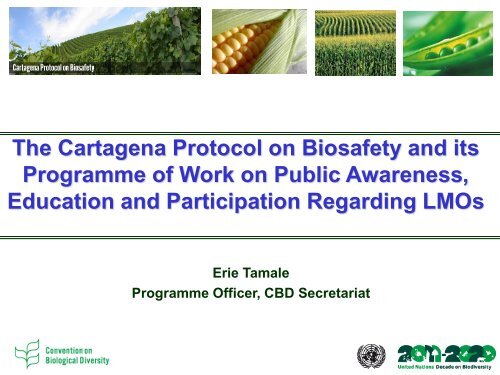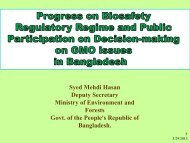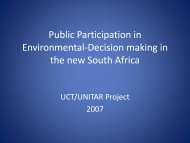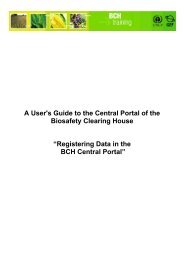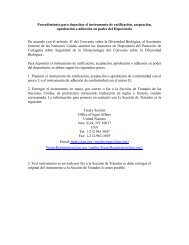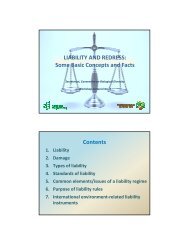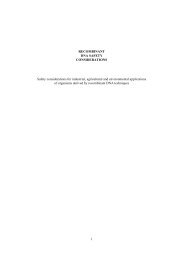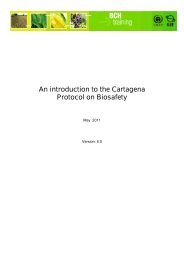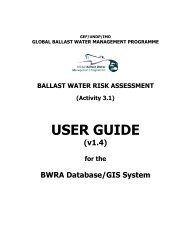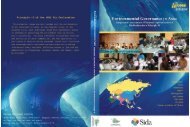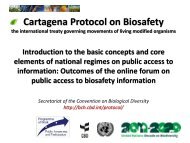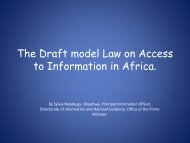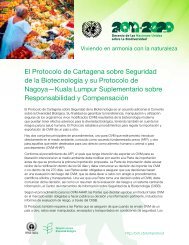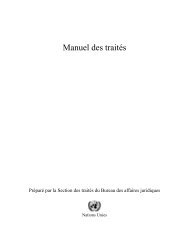The Cartagena Protocol on Biosafety and its Programme of Work on ...
The Cartagena Protocol on Biosafety and its Programme of Work on ...
The Cartagena Protocol on Biosafety and its Programme of Work on ...
You also want an ePaper? Increase the reach of your titles
YUMPU automatically turns print PDFs into web optimized ePapers that Google loves.
© Queensl<strong>and</strong> Museum<br />
© Rachel<br />
<str<strong>on</strong>g>The</str<strong>on</strong>g> <str<strong>on</strong>g>Cartagena</str<strong>on</strong>g> <str<strong>on</strong>g>Protocol</str<strong>on</strong>g> <strong>on</strong> <strong>Biosafety</strong> <strong>and</strong> <strong>its</strong><br />
<strong>Programme</strong> <strong>of</strong> <strong>Work</strong> <strong>on</strong> Public Awareness,<br />
Educati<strong>on</strong> <strong>and</strong> Participati<strong>on</strong> Regarding LMOs<br />
Erie Tamale<br />
<strong>Programme</strong> Officer, CBD Secretariat
OVERVIEW<br />
Part I: Background to the <str<strong>on</strong>g>Protocol</str<strong>on</strong>g><br />
Part II: Provisi<strong>on</strong>s <strong>on</strong> PEAP<br />
Part III: MOP Decisi<strong>on</strong>s <strong>on</strong> PAEP<br />
Part IV: PEAP <strong>Programme</strong> <strong>of</strong> <strong>Work</strong>
BACKGROUND<br />
• 1992 UNCED, Agenda 21 (Chapter 16)<br />
• Additi<strong>on</strong>al to CBD<br />
• Adopted 29 January 2000 by CBD Ex-COP<br />
• Entered into force: 9 September 2003<br />
• 166 ratificati<strong>on</strong>s/ accessi<strong>on</strong>s, latest Afghanistan<br />
• 6 governing body meetings (COP-MOP), COP-<br />
MOP 6 held October 2012 in Hyderabad, India<br />
• Nagoya – Kuala Lumpur Supplementary<br />
<str<strong>on</strong>g>Protocol</str<strong>on</strong>g> <strong>on</strong> Liability <strong>and</strong> Redress- adopted 15<br />
October 2010; 12 ratificati<strong>on</strong>s/accessi<strong>on</strong>s
PROTOCOL OBJECTIVE<br />
To c<strong>on</strong>tribute to ensuring the safe transfer,<br />
h<strong>and</strong>ling <strong>and</strong> use <strong>of</strong> LMOs resulting from<br />
modern biotechnology Access to genetic that resources may have<br />
adverse effects <strong>on</strong> the biological diversity,<br />
taking also into account risks to human<br />
health<br />
*In accordance with the precauti<strong>on</strong>ary<br />
approach
Provisi<strong>on</strong>s <strong>on</strong> PAEP<br />
Article 23 requires Parties to:<br />
• Promote <strong>and</strong> facilitate PAEP c<strong>on</strong>cerning the safe<br />
transfer, h<strong>and</strong>ling <strong>and</strong> use <strong>of</strong> LMOs; Cooperate in<br />
doing so<br />
• Ensure that PAE encompass access to informati<strong>on</strong><br />
<strong>on</strong> LMOs imported<br />
• C<strong>on</strong>sult the public in decisi<strong>on</strong>-making processes<br />
regarding LMOs; avail to them decisi<strong>on</strong>s taken<br />
• Inform the public about the means <strong>of</strong> public access<br />
to the <strong>Biosafety</strong> Clearing-House (BCH)
COP-MOP Decisi<strong>on</strong>s <strong>on</strong> PAEP<br />
MOP 2:<br />
• ES - intensify cooperati<strong>on</strong> with the Aarhus C<strong>on</strong>venti<strong>on</strong><br />
• Share info, experiences through BCH<br />
MOP 4:<br />
• Agreed to c<strong>on</strong>sider a programme <strong>of</strong> work <strong>on</strong> PAEP @ MOP 5<br />
• New SCBD Outreach strategy<br />
COP-MOP 5:<br />
• Adopt a programme <strong>of</strong> work <strong>on</strong> PAEP (2011-2015)<br />
• ES: Establish an <strong>on</strong>line forum <strong>and</strong> other means to facilitate<br />
exchange <strong>of</strong> informati<strong>on</strong>/experience <strong>on</strong> PoW implementati<strong>on</strong>
PoW <strong>on</strong> PAEP (2011-2015)<br />
<strong>Programme</strong> Elements:<br />
1. Capacity-building<br />
2. Public awareness <strong>and</strong> educati<strong>on</strong><br />
3. Public access to informati<strong>on</strong><br />
4. Public participati<strong>on</strong><br />
Each programme element includes:<br />
• Operati<strong>on</strong>al Objectives<br />
• Expected Outcomes; Indicators<br />
• Suggested Activities<br />
• Time Frame<br />
• Actors
PoW-PAEP: Element 1- Capacity Building<br />
1. Legal/policy frameworks <strong>and</strong> mechanisms<br />
for PAEP in place<br />
2. Instituti<strong>on</strong>al mechanisms established:<br />
• Advisory committees, informati<strong>on</strong> centres<br />
• Collaborati<strong>on</strong> with Aarhus C<strong>on</strong>venti<strong>on</strong><br />
3. Human resources developed:<br />
• Roster <strong>of</strong> experts<br />
• Training programmes for biosafety<br />
educators/communicators<br />
• Guidance materials<br />
4. Mechanisms for collaborati<strong>on</strong>/sharing <strong>of</strong><br />
experience, resources in place
PoW-Element 2 – Awareness/Educati<strong>on</strong><br />
Promote public awareness <strong>and</strong> educati<strong>on</strong>:<br />
• Baseline awareness surveys undertaken<br />
• Awareness plans/programmes in place<br />
• Awareness materials dev./disseminated<br />
in various languages<br />
• Use <strong>of</strong> media enhanced<br />
• <strong>Biosafety</strong> integrated into curricula<br />
• E-learning tools, educati<strong>on</strong> packages<br />
developed<br />
• Collaborati<strong>on</strong> with schools enhanced
PoW-Element 3 – Access to informati<strong>on</strong><br />
1. Popularise the right <strong>of</strong> access to<br />
informati<strong>on</strong> (ATI)<br />
2. Popularise means <strong>of</strong> access<br />
3. Establish instituti<strong>on</strong>al mechanisms<br />
<strong>and</strong> infrastructure to facilitate ATI,<br />
e.g. websites, BCH nodes<br />
4. Informati<strong>on</strong> alert systems<br />
5. Establish procedures for access to<br />
informati<strong>on</strong>
PoW-Element 4 – Public participati<strong>on</strong><br />
1. Establish PP frameworks <strong>and</strong> SOPs<br />
2. Administrative mechanisms/systems<br />
for PP<br />
3. Public notificati<strong>on</strong> <strong>of</strong> PP<br />
opportunities<br />
4. Platforms for public feedback,<br />
comments<br />
5. Availing resources to facilitate PP<br />
6. Popularise the right to PP in<br />
d/making
CPB Strategic Plan elements <strong>on</strong> PAEP<br />
OP 2.5 (Enhance capacity for PAEP)<br />
• Access to guidance/training materials <strong>on</strong> PEAP<br />
• Training in PAEP skills<br />
• Mechanisms for ensuring PP in d/making<br />
• Informing the public <strong>on</strong> modalities for participati<strong>on</strong><br />
OP 5.3 (Communicati<strong>on</strong> <strong>and</strong> outreach)<br />
• Awareness/outreach programmes<br />
• Nati<strong>on</strong>al communicati<strong>on</strong> strategies<br />
• <strong>Biosafety</strong> websites, searchable databases<br />
• Awareness/educati<strong>on</strong>al materials
WAY FORWARD<br />
• Nati<strong>on</strong>al PEAP Acti<strong>on</strong> Plans (within NBF framework)<br />
• Regi<strong>on</strong>al <strong>and</strong> internati<strong>on</strong>al cooperati<strong>on</strong> (including<br />
through regi<strong>on</strong>al organizati<strong>on</strong>s <strong>and</strong> networks (e.g.<br />
ASEAN, UNEP regi<strong>on</strong>al <strong>of</strong>fices, etc.)<br />
• Regi<strong>on</strong>al biosafety PEAP networks/ websites<br />
• Cooperati<strong>on</strong> with Aarhus C<strong>on</strong>venti<strong>on</strong> <strong>and</strong> other<br />
relevant instruments<br />
• Maximise use <strong>of</strong> existing tools (e.g. <strong>on</strong>line forum <strong>on</strong><br />
PAEP, baseline survey templates, BCH-BIRC, PEAP<br />
portal in the BCH, etc.)
CONCLUDING REMARKS<br />
• Article 23 <strong>on</strong> PEAP critical to the successful<br />
implementati<strong>on</strong> <strong>of</strong> the <str<strong>on</strong>g>Protocol</str<strong>on</strong>g><br />
• <str<strong>on</strong>g>The</str<strong>on</strong>g> CPB has moved to a new phase implementati<strong>on</strong><br />
to be guided by a Strategic Plan 2011-2012<br />
• PoW <strong>on</strong> PAEP: A useful framework to guide acti<strong>on</strong><br />
• Important to keep abreast with new developments<br />
• <str<strong>on</strong>g>The</str<strong>on</strong>g> BCH is a key source <strong>of</strong> informati<strong>on</strong><br />
• Maximise the tools developed through the BCH to<br />
facilitate implementati<strong>on</strong> <strong>of</strong> the PoW: the PEAP<br />
portal, regi<strong>on</strong>al PEAP networks, survey templates
For Further Informati<strong>on</strong> C<strong>on</strong>tact:<br />
Secretariat <strong>of</strong> the C<strong>on</strong>venti<strong>on</strong> <strong>on</strong><br />
Biological Diversity<br />
413 Saint Jacques Street, Suite 800<br />
M<strong>on</strong>treal, QC, H2Y 1N9, Canada<br />
Tel: +1 514 288 2220<br />
Fax: + 1 514 288 6588<br />
Email: secretariat@cbd.int<br />
<str<strong>on</strong>g>Protocol</str<strong>on</strong>g> URL: http://bch.cbd.int/protocol<br />
PAEP tools in the BCH:<br />
http://bch.cbd.int/<strong>on</strong>linec<strong>on</strong>ferences/portal_ar<br />
t23/pa_main.shtml


